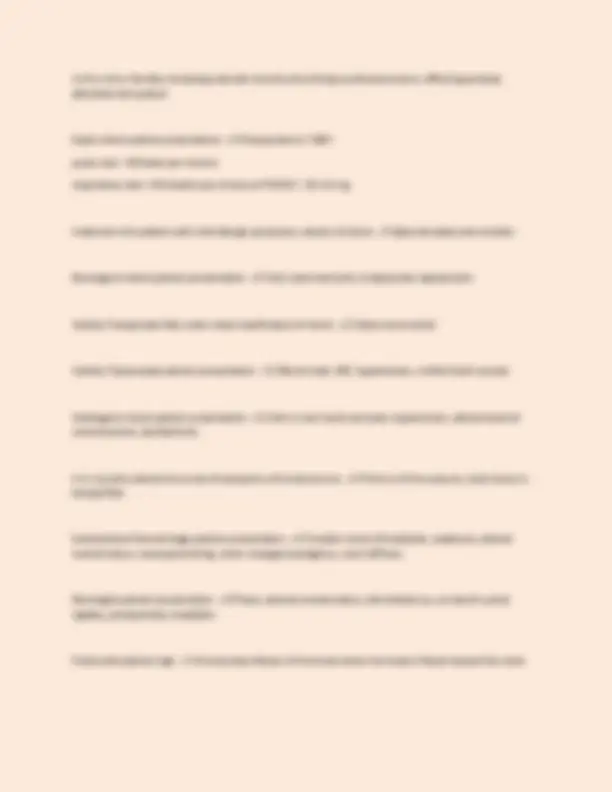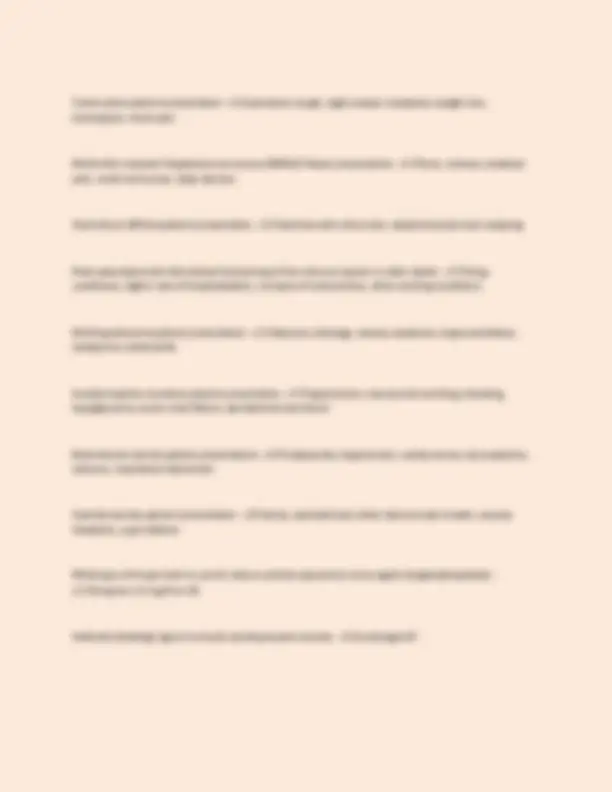





Study with the several resources on Docsity

Earn points by helping other students or get them with a premium plan


Prepare for your exams
Study with the several resources on Docsity

Earn points to download
Earn points by helping other students or get them with a premium plan
Community
Ask the community for help and clear up your study doubts
Discover the best universities in your country according to Docsity users
Free resources
Download our free guides on studying techniques, anxiety management strategies, and thesis advice from Docsity tutors
The first action in Assessment pathway is - ✔✔safety and initial observations, then identify and manage life threats. Understanding first impression and initial observation about a patient's body positioning can be an early indicator of - ✔✔sick or not sick Paroxysmal Nocturnal dyspnea is most common in - ✔✔left side heart failure CPAP is used on - ✔✔alert patient's, patient's who follow commands, and patients who do not have hypotension CPAP can be used on asthmatic patients - ✔✔not responding to nebulizer treatments On the exam choose - ✔✔B supplemental oxygen and suction Histamines and Leukotrienes primarily cause - ✔✔vasod
Typology: Exams
1 / 5

This page cannot be seen from the preview
Don't miss anything!




The first action in Assessment pathway is - ✔✔safety and initial observations, then identify and manage life threats. Understanding first impression and initial observation about a patient's body positioning can be an early indicator of - ✔✔sick or not sick Paroxysmal Nocturnal dyspnea is most common in - ✔✔left side heart failure CPAP is used on - ✔✔alert patient's, patient's who follow commands, and patients who do not have hypotension CPAP can be used on asthmatic patients - ✔✔not responding to nebulizer treatments On the exam choose - ✔✔B supplemental oxygen and suction Histamines and Leukotrienes primarily cause - ✔✔vasodilation during anaphylaxis Pathophysiology of asthma - ✔✔chronic inflammation of the bronchi with contraction of the bronchial smooth muscle, resulting in narrowed bronchi and associated wheezing. Signs and symptoms of asthma - ✔✔Wheezing, dyspnea, chest tightness. Asthma is NOT associated with fever or stridor Pathophysiology of COPD - ✔✔chronic inflammation from exposure to inhaled particles injuries of the airway.
Signs and symptoms of COPD - ✔✔dyspnea, intolernce to exertion, wheezing, production cough, accesory muscle use, JVD, rhonchi ALI/ARDS (acute lung injury/acute respiratory distress syndrome) - ✔✔breakdown of the alveolar- capillary border that allows fluid to seep into the alveoli, decreasing gas exchange in the lungs Be aware that a PE is characterized by a sudden onset of - ✔✔dyspnea, especially in the COPD patient Breath sounds heard most often with early presentation of PE - ✔✔new onset wheezing Signs and symptoms of PE - ✔✔chest pain, chest wall tenderness, dyspnea, tachycardia, syncope, hemoptysis, new onset wheezing, new cardiac arrythmia, thoracic pain Physiological changes associated with advancing age that leads to increased risk for respiratory compromise - ✔✔thinning of epithelial linings, decreased mucus production, flagging activity if respiratory cilia, reduced lung compliance, decreasing respiratory surface area, reduced intrathoracic volume, less vigorous immune response, weakened muscles of respiration Typical symptoms of ischemic chest pain - ✔✔chest pain, tightness, shortness of breath Atypical symptoms of ischemic chest pain - ✔✔back pain, fatigue, nausea, vomiting A complete OPQRST and SAMPLER are important in the assessment of - ✔✔cardiovascular disorders. Familial history is important, but recent cardiovascular interventions are more pertinent in determining acuity level 12 lead ECG presentation in patients with pericarditis - ✔✔ST elevation in every lead. QRS complexes are notched Activation of the renin-angiotensin aldosterone system - ✔✔when blood flow to the kidneys is restricted, this system is activated. sodium carries water back into the vasculature instead of excreting it
Lower left quadrant differential diagnosis of abdominal pain - ✔✔aortic aneurysm, diverticulitis, ectopic pregnancy, ovarian torsion, PID, UTI, endometriosis What type of GI bleed is associated with melena - ✔✔upper GI bleed metabolic acidosis - ✔✔blood gas level lower than 7.35-7. Cullen's sign - ✔✔a blue discoloration around the umbilicus Most common underlying medical condition associated with acute pancreatitis - ✔✔diabetes Appendicitis patient presentation with psoas sign - ✔✔psoas sign- exacerbation of pain in the right lower quadrant. other s&s - fever, nausea and vomiting Gastroenteritis patient presentation - ✔✔diarrhea, abdominal cramps, nausea, vomiting, fever, anorexia Beta-blocker use in treatment of thyroid storm - ✔✔block the peripheral adrenergic hyperactivity Hyperglycemia signs and symptms - ✔✔polyuria, polydipsia, polyphagia HHNC initial treatment - ✔✔ABC's, IV fluids, monitor and transport HHNC (hyperosmolar hyperglycemia nonketotic coma) patient presentation - ✔✔fever, dehydration, vomiting and abdmonial pain, hypotension, tachycardia, rapid breathing, altered loc, seizures Narcotic overdose can lead to - ✔✔respiratory acidosis What can lead to respiratory alkalosis - ✔✔pulmonary, infections, drug induced, hypoxia, hyperventilation, metabolic and electrolyte disturbances
Tuberculosis patient presentation - ✔✔persistent cough, night sweats, headache, weight loss, hemoptysis, chest pain Methicillin-resistant Staphylococcus aureus (MRSA) Patient presentation - ✔✔fever, redness, localized pain, small red bumps, deep abscess Clostridium difficile patient presentation - ✔✔diarrhea with a foul odor, abdominal pain and cramping Risks associated with diminished functioning of the immune system in older adults - ✔✔living conditions, higher rate of hospitalization, increase of malnutrition, other existing conditions Mild hypothermia patient presentation - ✔✔dizziness, lethargy, nausea, weakness, hyperventilation, tachypnea, tachycardia Acetaminophen overdose patient presentation - ✔✔hypotension, nausea and vomiting, bleeding, hypoglycemia, acute renal failure, dysrhythmia and shock Beta-blocker toxicity patient presentation - ✔✔bradycardia, hypotension, cardiac arrest, decreased loc, seizures, respiratory depression Cyanide toxicity patient presentation - ✔✔anxity, dysrhythmias, bitter almond odor breath, nausea, headache, pupil dilation What type of drug is best to use for seizure activity exposed to nerve agent (organophasphate) - ✔✔Atropine 1 - 5 mg IV or IM Hallmark (leading) sign of a tricyclic antidepressant toxicity - ✔✔prolonged QT